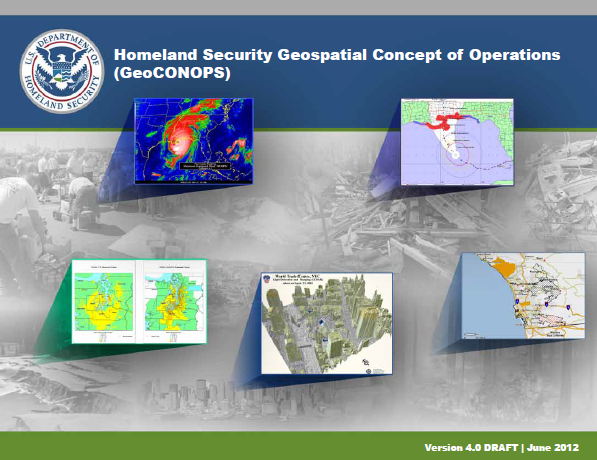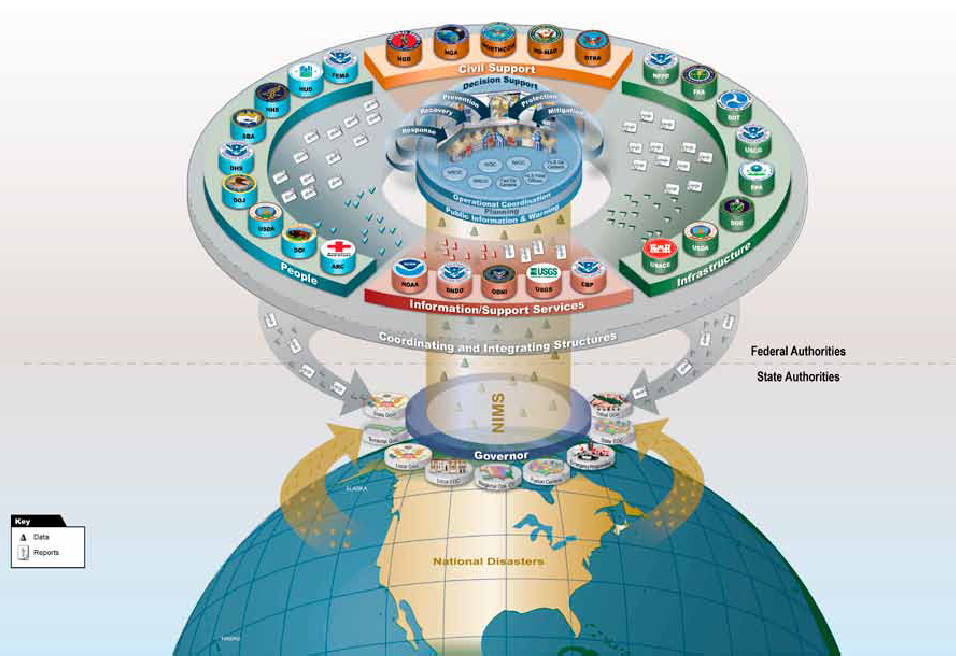The following document is version 4.0 of the DHS GeoCONOPS, formerly known as the Federal Interagency Geospatial Concept of Operations. A quick start guide was also released with the updated GeoCONOPS in June 2012.
Homeland Security Geospatial Concept of Operations (GeoCONOPS) Version 4.0
- Draft
- 190 pages
- June 2012
- 3.64 MB
The Homeland Security Geospatial Concept of Operations (GeoCONOPS) is a multiyear effort focused on the geospatial communities supporting DHS and FEMA activities under the NRF and in coordination with Presidential Policy Directive 8: National Preparedness (PPD-8) which describes the Nation’s approach to preparing for the threats and hazards that pose the greatest risk to the security of the United States. The GeoCONOPS, in its fourth year, is a multiyear product to document the current geospatial practices supporting the NRF, PPD-8, and Stafford Act activities. The participants and intended audience of the GeoCONOPS include the GIOT Members, 15 Emergency Support Functions (ESF), both primary and support, and other federal mission partners. The GeoCONOPS will be updated on a yearly basis to ensure it meets the needs of all mission partners. The GeoCONOPS is currently under review by FEMA for adoption by NIMS.
…
DHS is relying more often and more broadly on geospatial information technology to collect and analyze key situational awareness data for its emergency response missions. According to the National Strategy for Homeland Security and DHS’s mission statement: homeland security covers prevention, protection, mitigation, response, and recovery. Geospatial products and intelligence play a key role in the Department’s preparation for disasters and its response to them; they are used to help assess damage, aid in search and rescue (SAR), remove debris, and support incident management.
The Geospatial Management Office (GMO) serving the DHS Chief Information Office, was established by the Intelligence Reform and Terrorism Prevention Act of 2004 (Title VII, Subtitle B, Section 8201, Homeland Security Geospatial Information). Through its implementation of DHS Management Directive 4030, the GMO exercises executive leadership in establishing DHS geospatial information technology programs, directives, and initiatives and provides oversight for the integration of geospatial data 1 See Annex C for a complete list of federal partners. and technology. It serves as the principal office to facilitate all interagency activities relating to domestic geospatial and remote sensing (RS) data to support the needs of homeland security-related intelligence, law enforcement, environmental, scientific, and emergency response requirements.
The GMO must develop requirements and processes for access to common operating data used by components and provide guidance to other federal departments and agencies that are supporting and executing homeland security and emergency management operations.
Geospatial technology provides a significant role in incident management. Its uses today include disaster early warning and mitigation, border monitoring, criminal investigations, public health protection, and critical infrastructure oversight. In recent years, federal mission partners have been operating with minimal formal guidance or direction on how to conduct geospatial support to the emergency response and homeland security operating regimes, relying instead on ad hoc coordination.
As a result, geospatial efforts in support of incident management have frequently been slow to start or have been completely unavailable immediately following a disaster, leaving the “full power” and benefits of geospatial technology unrealized. The development of the GeoCONOPS for homeland security and emergency management operations ensures that timely and accurate geospatial data is shared across the entire geospatial community, resulting in better informed decision making across all phases of an incident.
…
…
GIOT Team Members
Department of Agriculture (USDA)
– Office of the Chief Information Office
— Enterprise Geospatial Management Office
– Office of Homeland Security & Emergency Coordination
— Emergency Operation Center
– Forest Service
— National Interagency Fire centerDepartment of Commerce (DOC)
– National Oceanic & Atmospheric Administration (NOAA)
– US Census BureauDepartment of Defense (DoD)
– Office of the Deputy Undersecretary for Defense
— National Geospatial-Intelligence Agency (NGA)
— National Guard Bureau
— NORTHCOM
— US Army Corps of Engineers (USACE)Department of Health & Human Services (HHS)
Department of Homeland Security (DHS)
– Office of the Chief Information Officer/Geospatial Management Office (GMO)
– Customs and Border Patrol (CBP)
– Federal Emergency Management Agency (FEMA)
— Federal Insurance & Mitigation Administration (FIMA)
— Office of Response & Recovery (ORR)
— National Preparedness Directorate (NPD)
— National Exercise Division (NED)
— National Integration Center (NIC)
– Mission Support Bureau (MSB)
— Office of the Chief Information Officer (CIO)/Geospatial Solutions Branch
– Federal Law Enforcement Training Center (FLETC)
– Immigration & Customs Enforcement (ICE)– National Protection & Programs Directorate (NPPD)
— Federal Protective Service (FPS)
— Office of Infrastructure Protection (IP)
– Office of Health Affairs (OHA)
– Office of Intelligence and Analysis (I&A)
– Office of Operations Coordination & Planning (OPS)
– Science and Technology (S&T)
– Transportation Security Administration (TSA)
– US Coast Guard (USCG)
– US Secret Service (USSS)Department of Housing & Urban Development (HUD)
Department of Interior (DOI)
– US Geological Survey (USGS)Department of State
– USAIDDepartment of Transportation (DOT)
Environmental Protection Agency (EPA)
Federal Aviation Administration (FAA)
Office of the Director of National Intelligence (ODNI)
– Program Manager for the Information-Sharing Environment (PM-ISE)Small Business Administration (SBA)
Veterans Administration (VA)
Collaborating Partners
American Red Cross (ARC)
National Alliance for Public Safety GIS (NAPSG)
National States Geographic Information Council (NSGIC)
Open Geospatial Consortium (OGC)



